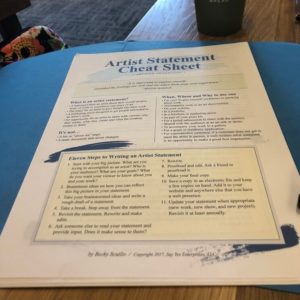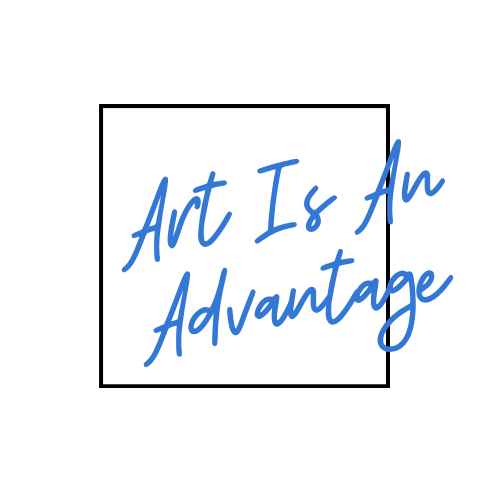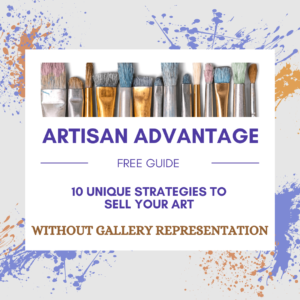by Rebecca Sciullo | Oct 28, 2019 | Learning, Resources, Your Artist Statement
Many artists dread writing an artist statement. They will write a statement when required to do so for an application, a submission, or to accompany an exhibition. While professional artists realize that the artist statement is necessary, and will write one when required to do so, they may not find the process comes easily to them. Also, there are some misconceptions out there when it comes to what an artist statement is.
Let’s review the what and why of an artist statement. I hope to persuade you to write the best one possible for your body of work.
What Is An Artist Statement?
Your artist statement is a written document that explains your intention for your body of work. It helps the reader to understand your work better and could entice them to view it if they have not seen it before.
There are different ideas about what an artist statement should contain and how to write one. A useful statement is one that makes someone want to view your work if they have not done so before. Or, it makes them want to take a second look at your work. It teaches or gives the viewer insight into something they may not know about the work by just looking at it.
Your artist statement is not your bio or about me page. Instead, it is primarily about your work, not your background. Your bio and artist resume/cv should exist separately from your statement.
I encourage you to craft the most effective statement you can for your work at this moment in time.
Why Should You Write an Artist Statement?
The artist statement is more than just a written document about your work. To succeed with your visual art business, you need to stand out, get noticed, and make a connection with people in a noisy world. The artist statement helps you to do that. It is your opportunity to help people to view and understand your artwork, especially when you are not there to speak with them. Also, it forces you to clarify what you want to communicate about your work. By doing this, you will be better prepared to speak and present your work, whether it is in a formal or informal setting.
 The bottom line – an artist statement prepares you for the opportunities that come your way, which is WHY you need to have one that effectively represents your work. Visit the Artisan Advantage Resources page for some tools to help with writing your artist statement.
The bottom line – an artist statement prepares you for the opportunities that come your way, which is WHY you need to have one that effectively represents your work. Visit the Artisan Advantage Resources page for some tools to help with writing your artist statement.
Sign up for the Artisan Advantage Newsletter to get a copy of this Cheat Sheet and more!
by Rebecca Sciullo | Feb 7, 2018 | Consultations, Learning, Your Artist Statement
“We ask you to submit your artist statement as well as images and information about your artwork to be juried by our panel.”
“You must submit your artist statement and CV with the online application.”
“If you are interested in exhibiting your work in the gallery, please submit your artist statement and samples of your work.”
“To complete your registration submit your artist statement…”

Are you serious about your visual art business? If so, you are likely familiar with requests like the ones above. If you haven’t yet, you will eventually need an artist statement. Don’t wait until the last-minute. Take time to write your artist statement sooner, rather than later. The best way to write an effective statement that connects with your viewers is to do it in advance. You will be better prepared for opportunities. Also, you will be better equipped to speak clearly about your work.
Get help writing your artist statement.
If you are in need of an artist statement or need to update an existing statement, let me help you. My “Writing an Effective Artist Statement” Micro Consulting session is designed to help you produce the perfect statement for your work. I am offering these sessions for a limited time during the months of February and March. Click here to learn more about how you can schedule a session and get that statement written.
Photo by JESHOOTS.COM on Unsplash
by Rebecca Sciullo | May 8, 2017 | Events, Your Artist Statement
Are you struggling to write an artist statement? Do you need an artist statement, but are unsure where to begin writing one?
Pittsburgh and surrounding area artists are invited to participate in an Art Marketing Round Table Discussion, hosted by Gilberti Fine Art Studio and Gallery in Coraopolis, PA. Art marketing consultant Becky Sciullo and artist/gallery owner Cindy Gilberti will lead a discussion focused on writing an artist statement. There are two different opportunities to attend in order to accommodate schedules.
The round tables will start with a short 15 minute overview of the topic, followed by group discussion with an opportunity for artists to ask questions, share ideas and listen to what other artists have to say about the topic.
The events are free of charge. Size is limited to 15 participants per session and pre-registration is required. Please register at one of the links below.
If you have an artist statement that you’d like to share or review, bring it along. If not, that’s fine too! Just come prepared to take notes.
Sign up for one of the sessions below!
Tuesday June 20th
10 am – 12 pm
Saturday June 24th
10 am – 12 pm
by Rebecca Sciullo | Mar 31, 2017 | Uncategorized

Your artist statement should be a reflection of you and your work. You are telling your audience what you want them to understand about your art. You are explaining to them why they should want to look at your work.
- Write it in the first person.
- Write about your creativity, emotions and things that influence your art.
- Keep it real. Make it an authentic representation of you and your work.
- Keep it concise and clear. Your audience will thank you.
- It should represent current work.
- Consider multiple versions for different bodies of work.
- Tell people what you want them to know about your work.
- Keep a journal as you work, writing down thoughts that come to you about influences and ideas that you have along the way. It will be helpful to you when you sit down to write your statement.
Your bio is a highlight of your background, career and accomplishments. Think of it as a snapshot of your CV or resume.
- Write it in the third person.
- Include recent highlights and accomplishments such as awards, publications, notable commissions, etc….
- Write both a short (50 to 100 words) and longer version of a couple of paragraphs.
- Add a quality head shot.
For both the artist statement and biography you want to do the following:
- Review and update at least once a year.
- Have them ready to go when you need them, both electronically and in print.
- Proofread!
- Ask someone else to proofread and for input.
Do you have a question about your artist statement or bio? Drop me a line at becky@artisan-advantage.com and I will try to help.
Do you think this article might help an artist you know? Please consider sharing on social media or forwarding via email with the buttons below.
Would you like more tips for your art business? Sign up for my free e-newsletter here.
Photo Credit: Alejandro Escamilla
 The bottom line – an artist statement prepares you for the opportunities that come your way, which is WHY you need to have one that effectively represents your work. Visit the Artisan Advantage Resources page for some tools to help with writing your artist statement.
The bottom line – an artist statement prepares you for the opportunities that come your way, which is WHY you need to have one that effectively represents your work. Visit the Artisan Advantage Resources page for some tools to help with writing your artist statement. 


